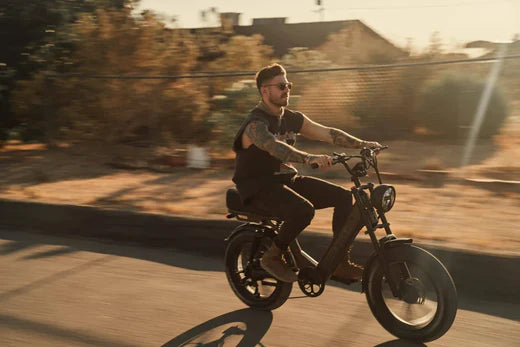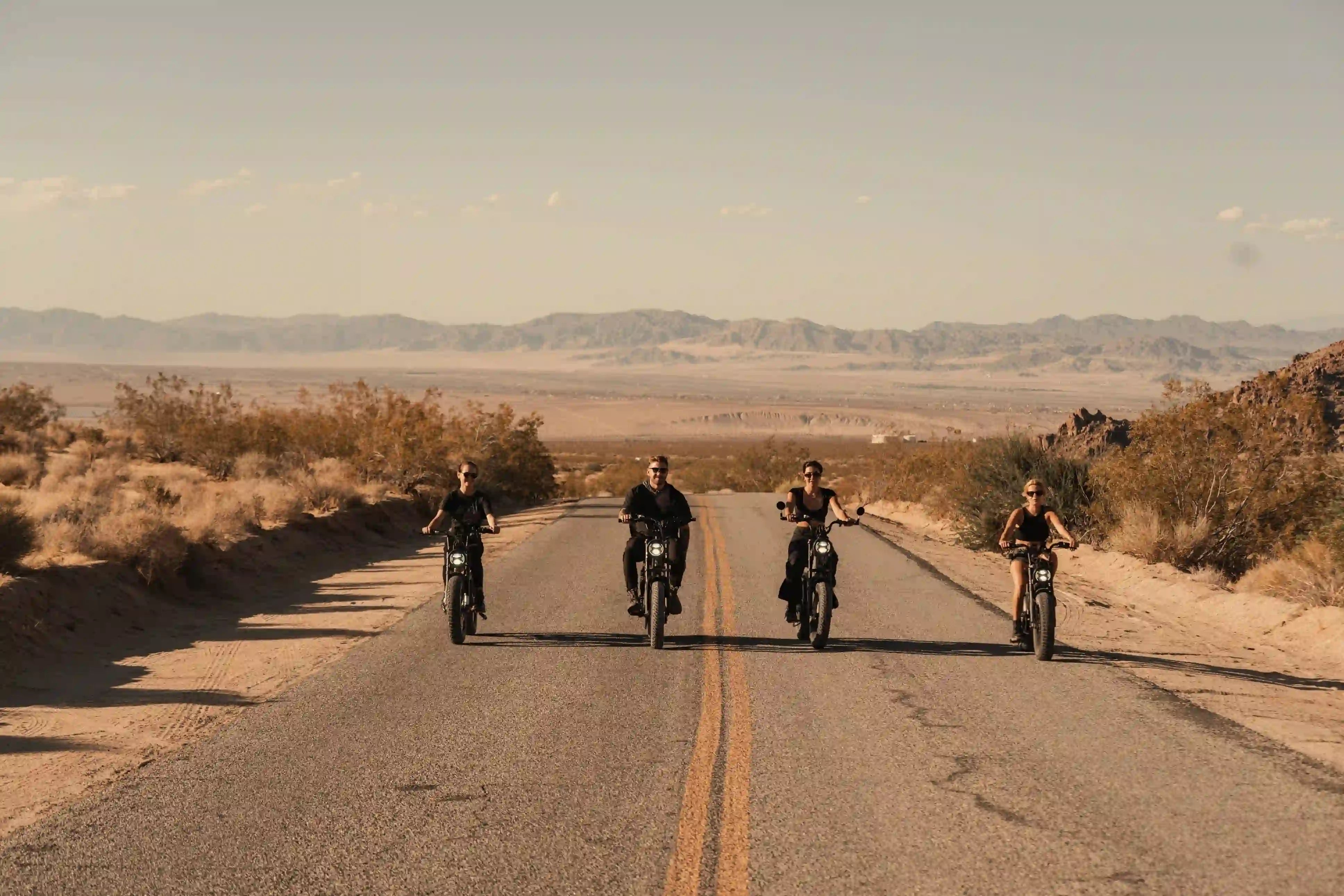One of the relatively new alternatives in the sphere of transportation is an electric bike, commonly abbreviated as E-bike. The electric bike is defined as a bicycle with a motor driven by a battery. It makes a really safe, affordable, and convenient mode of transport for people. So if you are thinking about purchasing an E-bike, there are some important considerations to make. But within this Aperyder Ultimate Electric Bike Guide 2024, we are going to discuss some of the main things: different categories of E-bikes, how they work, and what to consider before purchasing.
After reading the content, don't forget to check out Ape Ryder's all e-bike collection.
What is an Electric Bike (E-bike)?
What's so exciting about an electric bike, or E-bike? Well, an e-bike is just a bicycle with an electric motor that assists one's pedaling, letting you continue on much longer with much less effort. An e-bike offers wonderful alternatives to traditional bicycles and a way eco-friendlier ride than the traditional modes of transport. They are an excellent alternative for a commuter looking to lower their carbon footprint and be a part of a viable change in everyday actions.
How Does an E-Bike Work?
E-bikes are fitted with a rechargeable battery, mostly mounted on the frame. The batteries provide electric energy to power a hub motor, which assists the pedals. As one pedals, it automatically starts movement of the bike forward, making pedaling easier. Most e-bikes have variable power modes that allow the rider to select how much assistance the motor gives.
Classes of E-bikes
There are three classes of electric bikes you should know about:
Class 1
This class E-bike provides power only while pedaling. This is for those that want a little more activity during their ride. Its top assisted speed tops out at 20 mph, letting you glide through the various terrains with the support of the electric motor.
Class 2
This ebike is equipped with a throttle to ride the bike on pure power, with no pedaling at all. It provides a comfortable and controlled ride at a maximum assisted speed of 20mph, blending power with ease.
Class 3
Pedal-assist e-bike - this E-bike will amplify your pedaling power with a quiet, efficient motor at the pedals, allowing simple work of uphill climbs and longer rides. It comes with a top speed of 28 mph with awesome speed and great control - just perfect for those who want a dynamic feel in their ride.
Who Is E-Bikes Suitable For?
Electric bikes are great for riders of any age or ability. They offer the senior citizen a way to have some fun, safety, comfort, and independence in their fitness and other daily chores. For people who find riding long distances a challenge, E-bikes make them bearable due to a boost in power at times one needs it the most.
Electric bikes are very good for kids to gain confidence on two wheels, which would make any transition into adult cycling that much easier. Varying settings and powerful motors make the machines adaptable to cope with weight and ability, allowing kids to feel the excitement of biking without their needing to provide all the power themselves.
Different Types and Models of Electric Bikes
They come in various styles and designs; the type that will be considered best for you depends on what use you have in mind and your personal preference. Following are a few different types of electric bikes available:
Commuter E-Bikes
Commuter e-bikes have end up very popular amongst urban dwellers in recent times because of the less expensive and cleaner modes of movement than vehicles. Now, with the advent of electrical-help bikes, commuting to work couldn't get easier. In this blog, we can dive into the exceptional types of commuter bikes so you may also select the precise one for your wishes.
E-Mountain Bikes
If you have a longer ride with rough terrain, an e-mountain bike (e-mtb) may be the right commuter bike for you. While they are designed for off-road trails, they will have no problem carrying you along city streets. They have thicker tires with a suspension system that makes for a comfortable ride over bumpy roads. Some mountain bikes even come with an electric-assist option nowadays, making it even easier to climb hills.
Folding E-Bikes
If you live in a small apartment or work in a small office space, the folding e-bike could be right up your alley. Then there are compact enough bikes to fit inside a closet or under a desk that attract a lot of urban commuters. They also come in electric-assist options and fold up easily for bringing on public transportation to make it easy to combine biking with other modes of transportation.
Cargo E-Bikes
It may turn out to be the cargo bike: ideal for those who need to move lots of groceries, kids, or work supplies. Cargo bikes have an expansive basket or platform capable of carrying a large load. They are available in electric assist models as well. They will be perfect for families or small business owners who have to move bulky items around without using a car.
Cruiser E-Bikes
They're first-rate cruiser bikes for shorter commutes on flat roads. The models include snug seats, smooth handlebars, and a clean experience. They're also excellent for riders searching out a clean, fashionable, no-frills look. While now not electric powered-help, they are very low priced and occasional protection.
Fat Tire Bikes
Another great option for people with snowy or sandy commutes is fat tire e-bikes. The large, oversize tires allow for fantastic grip and stability, perfect for off-road adventure riding or harsh weather conditions. They also come in electric-assist options, which help in steep hills or really long distances. Bonobo and Gibbon e-bikes are classified in Fat tire e-bikes.
Urban & City E-Bikes
City bikes, otherwise known as urban bikes, are designed to be ridden in cities. These bicycles are normally constructed to have a rather simple design, a comfortable seat, and light frames. They would also lend one features such as fenders, racks, and lights to make city commuting easier and safer. Electric-assist city bikes find great demand with those who might need to tackle hills or even cover longer commutes.
Where Can You Ride an E-Bike?
Varies from area to area; generally, places you're allowed to ride an E-bike are the same places a regular bike is allowed: bike paths and any roadways but not on the sidewalks. It's a good idea always to check with your local government for laws and regulations regarding riding your e-bike.
E-Bikes with Pedal Assist or Throttle Control
Pedal assist e-bikes, one needs to pedal so that the motor is triggered to assist. While in throttle-controlled, one does not have to pedal to have the motor assist. Pedal assist e-bikes are very common. This version offers a more natural cycling experience since one feels like they are getting some exercise. Throttle-controlled E-bikes offer convenience for relaxed riding.
How Far Can Electric Bikes Go?
It all depends on a number of factors, including battery capacity, nature of the terrain, weight of the rider, and the mode of assistance desired. Generally, ebikes go anywhere from 20-60 miles on one charge.
How Much Do Electric Bikes Cost?
Depending on the kind, brand, and version, an e-bike can be very cheap or extraordinarily expensive. The trendy view, but, locations electric powered bicycles among $1,500 and $5,000. At the high give up, some e-bike fashions even cost as much as $10,000. For that form of fee range, there's an option to in shape every wallet and preference. Whether you're within the marketplace for a budget or excessive-give up version, it does not remember; there are numerous alternatives to be had out within the open.
How Fast Do Electric Bikes Go?
The top speed of e-bikes is based on class. For Class 1, E-bikes that are power assisted by pedaling, it reaches a maximum assisted speed of up to 20mph. Meanwhile, Class 3 E-bikes, which have both power-assisted pedaling and a throttle, can reach a top speed of up to 28mph.
Are Electric Bikes Street Legal?
Electric bikes that meet preset Government standards are street legal. Generally, e-bikes capable of assisted 20 mph speeds or less in most states in the US are legal.
Do You Need a License for an Electric Bike?
An electric bicycle does not require licensing in most states in the US. This again is due to the view that electric bicycles present about the same level of risk as traditional bicycles. However, as always, keep in touch with your local regulations to see what requirements and restrictions might be applicable in your area. One has to put in the time to know the rules and regulations so as to stay safe and have fun while riding.
Benefits of Using E-bikes
E-bikes have many uses and benefits; some of them are these: I. Health: Ride an e-bike to get some workout while commuting. II. Nature: Electric bikes are eco-friendly and release less emission compared to conventional vehicles. III. Cost: Operations and maintenance of e-bikes are affordable as compared to the other traditional vehicles.
What are the Pros and Cons of E-Bikes?
E-bikes, for instance, are very famous due to the numerous reasons behind this preference. They are eco-friendly, energy-efficient, consequently lowering carbon emissions and reliance on fossil fuels. Added to that, e-bikes make riders' commutes easier and plenty extra a laugh-riders are capable of journey farther with less attempt. This convenience additionally allows living a more healthy life because people are much more likely to workout with biking if no longer as lots bodily power is wanted thanks to the support from a motor.
On the alternative hand, some of the great drawbacks to using an e-bike encompass the following ones; e-bikes are pretty highly-priced as compared to everyday bicycles, and this reality is going to influence the amount of capability consumers. Also, e-bikes are heavier because of the addition of a motor and a battery, hence not as handy to be carried or maneuvered while not in use. They will also need more maintenance compared to a standard bike since all electrical components, in addition to the battery, require regular care and occasional replacements. This adds cost and effort to owning the e-bike.
Where to Buy Electric Bike?
Looking for an e-bike? Look no further than Aperyder Retail Stores and Website. And if this is not the best news, then do not forget that all our E-bikes are pocket-friendly to ensure you get value for every dollar spent. So, wait no more, and visit Aperyder Retail Stores and Website for an electrifying biking experience!
How Much Care Do E-bikes Need?
Like another bicycle, e-bikes require the same type of renovation to have them serve their reason as efficiently as feasible. This involves normal cleaning, oiling chains, and most importantly, looking at tire pressure. Practices such as those will guarantee one in all a continuous and green running in their bike for an extended length. Having a longer lifespan and improving your driving experience with an e-bike can without difficulty be achieved through dedicating time to a number of the simple routine renovation responsibilities.
Can You Travel with an Electric Bike on a Plane?
This is usually allowed, however you could take a look at with an airline to go through any unique policies or regulations of the airlines concerning the transportation of digital bikes. This will similarly allow you to be organized earlier earlier than beginning the adventure without difficulty and with out hustle or chaos in travel.
How to charge an E-bike? How Long does it Take to Charge an E-bike?
However, at the same time as charging your e-motorcycle, please do observe the instructions of the manufacturer with due care. Since the commands make certain expert running with long lifestyles in your electric powered bike, they're followed. Generally, maximum e-bikes have fee instances ranging among 2-6 hours, wherein you'll price them to their full capability so you can ride freely without worries.
How Much Does an E-bike Weigh?
The weight of the electrical bike differs with the sort and logo. Generally, but, an e-bike will weigh between 35-70 lbs. At this degree, similarly determinants can be in a position to pull in both manner, relying on the frame fabric used, the dimensions of the battery, extra functions, among others.
Can You Ride an Electric Bike in the Rain?
Most e-bikes are built and designed for the street on most weather days, even wet ones. However, it would be prudent to avoid contact of water with the control panels and the batteries. By doing this, you may have insured safety this is needed for longer life and top-rated provider from such critical elements.
How to Find the Best Electric Bike in 2024?
First of all, a few factors have to be taken into consideration to select the best e-bike to your needs. Determine your budget to help narrow down your options. Second, consider what it's going to be used for: commuting, off-street, or just cruising around metropolis. Then there are personal alternatives for frame type, motor power, battery variety, and layout. Informed decision making would call for pretty some amount of homework in the shape of studies and analyzing through trusted reviews.
Do a journey take a look at on some E-bikes to look how they feel in regards to overall performance and luxury. From so doing, you will be positive to nail down the perfect e-bike suitable for your desires and places a smile in your face with every experience. Of direction, start with Aperyder e-bikes for your studies!
Do Electric Bikes Need to Be Registered?
Basically, in most states, you are not required to register your E-motorcycle; this is due to the fact they fall into the class of bicycles. However, it's far constantly well worth understanding and familiarizing yourself with the precise nearby regulations on your area. This will make sure that some short while spent discovering and expertise the rules and requirements will surely cross an extended manner in ensuring a safe yet exciting journey on an e-bike.
How Long Do Electric Bikes Last?
The lifespan of an e-bike is highly dependent on the type, usage, and level of maintenance accorded to the bike. To this end, proper care and regular maintenance will generally lengthen the life of an E-bike to between 3-5 years.,
Keep in mind, however, that its durability and lifespan could be influenced by a host of factors, such as the nature of the terrain, climate, or even handling. With proper e-bike choice for your intended purposes and well-timed maintenance, you may stretch life even further, making it possible to keep on enjoying all the benefits that electric biking has in store for you for years at a stretch.
Are E-bikes Safer than Regular Bikes?
E-bikes are considered to be a great deal safer than the conventional model of bicycles as it holds a more stable speed, which affords extra energy while one goes uphill. With their electric powered assistance, riders effortlessly and with ease triumph over tough terrain, making this bike model perfect for entertainment rides and additionally for adventurous explorations. In addition, the advanced degree of control or balance supplied by using e-bikes guarantees that riders of all talent degrees can ride their cycles confidently and enjoyably.
Parts of an Electric Bike
Some of the E-bike's parts include:
• Motor: The electric powered bike is usually liable for powering the e-bike to offer power and speed that ought to make certain a easy experience at the same time as the use of this bike. It's generally positioned inside the rear or front wheel, depending on the kind of e-bike.
• Battery: This part of the e-bike is designed to save electrical strength if you want to run the motor and is rechargeable as required. Most batteries can run 25 to 50 miles before needing a recharge.
• Display: An e-bike’s show unit allows riders maintain a file of pace, distance traveled, and other essential performance metrics in real-time.
• Brakes: There are both disc brakes or rim brakes mounted on an electric powered motorcycle, which assist the rider in speed manage and safe stops in any climate.
• Controller: This is that part of the bicycle that controls energy output from the motor, depending on a rider's needs and preference, and regulates battery existence—the rider can select from numerous degrees of battery-saving modes, like Eco or Tour mode. These features permit each bike owner to advantage extra range and premier performance for his or her e-bike in each ride.
• Pedal-assist: With pedal-help structures, the rider makes use of his or her legs to provide delivered help to the velocity being pedaled to enhance it and advantage in addition electricity; the rider nevertheless is predicated at the motor for usual propulsion. This characteristic is specially beneficial while conquering hills or traveling lengthy distance.
• Charger: An e-bike charger replenishes the power storage of a battery after a trip. Most chargers take everywhere from four to eight hours to charge fully, relying on the type and capacity of the battery. There are new models which have an choice for brief fee, which may additionally assist lots in saving time. Some higher-range e-bikes are also equipped with sun charging capabilities that enable the rider to fee his or her bike out within the path.
• Accessories: Last but no longer least, there may be plenty of E-bike add-ons aimed at enhancing the overall performance and riding enjoy of the user, inclusive of lights, racks, fenders, baskets, panniers, bells, and horns that make biking very clean and fun.
• Wiring and Connectors: For all the additives of the e-bike, they need to be related and stressed out properly to every other with the intention to function correctly. This stages from the motor being related to the battery, controller, and show unit through diverse wiring harnesses.
Do You Have to Pedal an Electric Bike?
When the use of electric powered bikes with throttle manipulate, you may simply stop pedaling. Nevertheless, in terms of pedal-help e-bikes, it's far recommended to pedal so that you get extra miles out of your battery and avoid overheating of the motor. The more you interact your self in pedaling, the extra distance you may be capable of journey and the greater efficient and efficient your e-bike trip can be.
How to Choose the Right E-Bike Size?
Having each your peak and inseam, you ought to pick a super-length e-bike. Using those numbers, carefully evaluate them against the manufacturer's chart a good way to expectantly locate an e-bike that might guarantee consolation and overall performance at their most. Remember, fitting an e-bike is just extraordinarily critical if you ever want to have amusing on a bike and be secure at the same time as using.
Things to Know Before Buying an Electric Bike
Before making a purchase, consider the following points:
• Your budget: Generally speaking, it is always necessary to consider buying an electric bike while remaining in one's budget.
• Type of E-bike needed: Do you want efficiency with pedal assist, or ease with a throttle control?
• Battery life: Consider battery power that can be enough to keep you riding as long as possible and to recharge.
• Weight capacity: Consider maximum weight for e-bikes and whether it would work well for you.
Another factor is your level of physical ability and fitness. If extra miles are what you want, then look at bikes that can provide you extra power and speed for cycling over a long distance. If you have some kind of physical disability, then an e-bike would be what you should look for, which would be light in weight and not hard to maneuver. You would assure yourself of picking the best e-bike if you kept your body type and riding style in mind.
Why Should You Have E-Bikes?
Some of the reasons you should have an E-bike include:
1. An e-bike is environmentally friendly, shifting round whilst decreasing carbon emissions with fun and efficiency. Using the right e-bike can get human beings round faster whilst reducing emissions. Besides this, driving an e-bike is good workout that allows reduce weight and improves coronary heart health. For example, Aperyder makes a speciality of Seatrees Foundation tasks and contributes to the mangrove forests.
2. The other huge positive for an electric powered bike is its possible in your price range gain over jogging a vehicle. Usually, an electric bike is tons cheaper to buy up front as compared to motors, especially in respect to gasoline and coverage prices. In addition to that, via having an electric powered bike, one could avoid the need to pay for registration, license plates, and the entirety similar.
3. While an electric powered bike is a completely time-green mode of shipping in comparison to a car, it can allow for a velocity of 25 miles in line with hour. This is quite fast in evaluation with a manual bicycle and accordingly will assist one easily attain where he wants with out such problem and wastage of so much time because of site visitors or just finding a parking spot. Furthermore, the electric assistance can enable one to peddle at a given speed without a single drop of sweat.
4. Electric bikes are fun rides and much more convenient than cars or ordinary bicycles as it involves less effort from the rider's part. Electric bikes are ideal for those people who want to stay active yet don't have enough time to pay for that activity.
Safety Tips for E-Bike
Safety when riding an e-bike has to be ensured for the sake of the rider and an enjoyable experience. Wearing a helmet is one of the most important precautions due to the fact it'll provide vital safety in case of an twist of fate. Maintain a secure speed, more so in an surroundings this is busy or crowded, for proper response in case there happens to be some thing surprising. Obeying the policies of the go with the flow of site visitors is very critical since it'll make you predictable to other street users; consequently, collision will be avoided.
Another crucial rule for secure using on an e-bike is to utilize biking paths whenever they may be available. This will minimize the chance of accidents from interacting with motor. Lastly, mechanical failure may be averted by making assessments on the condition of the bike regularly. Check on the brakes, tires, and battery to make certain the whole thing is k before hitting the street.
Are Electric Bikes Easy to Ride?
E-bikes, otherwise known as electric bicycles, are not only comparatively easy to ride but also give the cyclist a very pleasing experience. Inbuilt assistance makes cycling quite easy, more so through difficult terrains and uphill climbs. An added boost of power will help reduce the stress and effort normally associated with conventional cycling, allowing riders to fully immerse themselves in the joy of the journey.
How Should You Store Your E-Bike?
An best vicinity to shop your e-bike would be inside a dry and secure vicinity, like a garage or shed, wherein the bike is stored faraway from rain, snow, and excessive daylight. That manner, it enables to avoid viable harm to the bike's electric elements and might keep its service lifestyles longer. An additional bike cover or storing the cycle in a bicycle rack presents extra protection and maintains it from your way, freeing up space on your living location. By these easy precautions, you may make sure your e-bike is continually in pinnacle situation whilst you want to take it out on the next journey.
Why Aperyder E-bikes?
Aperyder E-bikes lead in quality, reliability, and budget. There are various choices of E-bikes depending on your need and taste. Not only that, but Aperyder donates to Seatrees Foundation for mangrove trees and primates. Additionally, Aperyder's attitude is to change everyday habits. Example: If you're going to go to the market with your car, don't. This time, travel by e-bike.
FAQ on Electric Bikes
Electric bikes, or e-bikes, have gained increasing popularity as convenient and ecological means of transportation. Here are a few frequently asked questions to help you understand how they work and what needs to be taken into account when buying one.
Do Electric Bikes Recharge While You Pedal?
Some electric bikes do have a regenerative device that renews the battery at the same time as pedaling. Basically, these structures take kinetic electricity supplied by way of braking or going downhill and flip it into electrical strength to later reintroduce into the battery for recharging.
Is Pedaling Required On An Electric Bike?
Pedaling is needed in most of them. Most electric powered bikes have distinctive modes of assistance-generally pedal-help and throttle modes. While the pedal assist mode is carried out, the motor assists the rider at one time while one is pedaling and amplifies one's pedaling energy. Throttle mode permits the rider to turn the motor on without pedaling-simply the energy of the motor.
Can Electric Bikes Handle Uphill Rides?
Electric bicycles are designed to make uphill riding simpler, as compared to ordinary bicycles. The purpose for this is that an electric powered motor offers brought power and torque that could help a rider cross up steep inclines with the strength output it presents. This assistive stage may additionally range among numerous using styles of riders or even primarily based on land characteristics.
Can You Achieve Weight Loss with An Electric Bike?
Yes, it is, considering with an e-bike, you'll still do some pedaling even though you have been receiving some shape of help. This frequently done may be a way of preserving low-intensity aerobic exercising to the factor that you will begin burning those energy, hence contributing to weight reduction.
Are Electric Bikes Effective For Exercise?
Yes, electric bikes can offer workout. E-bikes can offer greater reachable styles of physical hobby for all of us who can also find traditional cycling tough due to their fitness stage, any health issue, or because of hilly terrains in a place. They let the rider control the quantity of workout that they do with precision and deliver them a chance to increase workload progressively.
Can You Ride An E-Bike When The Battery Is Depleted?
Sure, you could journey an electric bicycle when the battery is useless or flat. However, the electrical bike could be very heavy without a battery and for this reason a whole lot harder to pedal than whilst the motor is supporting you ahead-it would feel much like a normal bicycle. You will locate it more tiring and exhausting up hilly areas or on longer rides. With the added weight of the motor and the battery, however, it isn't always quite as responsive as a everyday bicycle while the battery runs out.









Leave a comment
All comments are moderated before being published.
This site is protected by hCaptcha and the hCaptcha Privacy Policy and Terms of Service apply.